Most Significant Bagan Temples In Myanmar
Ananda Temple
The holiest and most important temple in Bagan houses four standing Buddhas facing towards the four cardinal points. The Ananda Temple is referred to as the ‘Westminster Abbey of Burma’. Displaying a mix of Mon and Indian architecture it was originally built in 1105 AD and is one of only four temples that survives within Old Bagan. The temple was extensively damaged by an earthquake in 1975 but has been restored with the spires being gilded in 1990 in preparation for the celebration of the 900th anniversary of its completion.
The name ‘Ananda’ derives from ‘anantapannya’ the Pali word for ‘boundless wisdom’.
The Buddha statues are made from teak wood gilded with gold leaf and the ones facing North and South are believed to be originals. The four Buddhas are (from left to right) :-
Kakusandha – North facing
Konagamana – East facing
Kassapa – South facing
Gautama – West facing

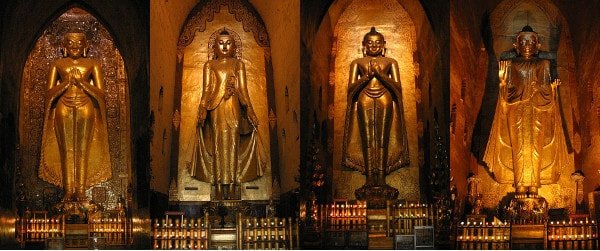
Shwesandaw Pagoda
One of the most popular places to watch the sun rise or set, this 5-tiered pagoda is located on the outskirts of Old Bagan and offers great views across the plain. Originally built in 1057 AD by King Anawratha the pagoda houses hairs from Gautama Buddha. Restoration work was undertaken following damage arising from the 1975 earthquake.
Great care should be taken when climbing the very steep steps that line the sides of the building.

Shwezigon Pagoda
This stunning and photogenic gold-leaf gilded pagoda is located in Nyaung U Town near to the river and is said to house a tooth and a bone of Gautama Buddha. Construction was started by King Anawratha in the 11th Century and was completed in 1102 AD by King Kyansittha. Surrounding the main pagoda are numerous interesting smaller temples and shrines.
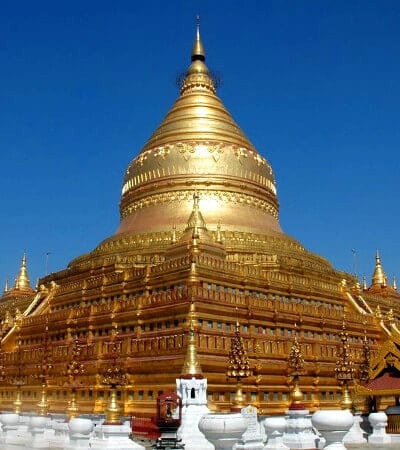
Thatbyinnyu Temple
The tallest temple in Bagan, reaching 61 metres (201 feet) high and with a floor plan in the shape of an unsymmetrical cross with gilded spires rising up from the corners of the terraces. It was constructed in the mid-12th Century during the reign of King Alaungsithu and consists of two levels with a seated Buddha on the second storey. One of the four temples that survives in Old Bagan and located just a short distance from the Ananda Temple.

Manuha Temple
This temple is named after its builder, the Mon King Manuha, who was held captive a couple of kilometres south of Bagan at Myinkaba. The temple is rectangular in shape, consisting of two storeys with the upper storey being smaller than the lower and houses three Buddhas seated in uncomfortably cramped positions as well as an image of a smiling reclining Buddha entering Nirvana which it is said are designed to depict the king’s own discomfort at being held prisoner and that his only happiness will come upon his death. The temple is one of the oldest in the region being completed in 1067 AD and although the earthquake of 1975 damaged the roof and the largest seated Buddha both have since been repaired.
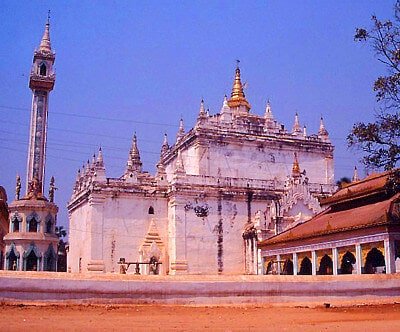

Shwegugyi Temple
According to the Pali inscriptions on the stone slabs set into the interior walls that detail the history of the temple it was constructed in just seven months by King Alaungsithu in 1131 AD. Featuring a seated Buddha image in the devotional hall and surrounded by fine stucco carvings. The temple stands on a huge three-metre high red brick plinth and is located near the Ananda Temple in Old Bagan.
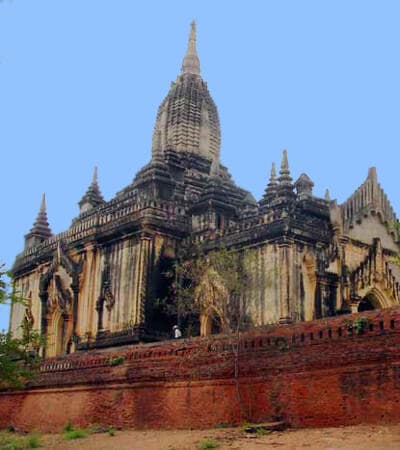
Dhammayangyi Temple
The largest temple in Bagan is located about a kilometre south of the Ananda Temple close to the the Shwesandaw Pagoda. It was built by King Narathu who came to power after killing his father and brother, reigning from 1167 AD to 1170 AD and is commonly though to have been constructed as an atonement. Why the central portion of the temple is bricked up is unknown but there is still access to the four porches which hold Buddha images and the outer corridor.

Sulamani Temple
One of the most visited temples due to its fine condition, large size and because stairs lead up to the higher levels providing great panoramic views over the plain especially at sunrise and sunset. Four Buddha images face outwards from the four sides at ground level and inside there are some of the finest stucco carvings in Bagan. The temple was completed by King Narapathi Situ in 1183 AD and was restored to its present condition in 1994 AD after sustaining damage during the 1975 earthquake.

Gubyaukgyi Temple
Displaying a fusion between Indian and Mon architecture this interesting temple is located south of Bagan on the way to the Manuha temple. It was built in 1113 AD by Prince Rajakumar upon the death of his father King Kyansittha. Featuring fine stucco work and 547 well-preserved paintings measuring about forty centimetres each which narrate Buddha’s previous lives and wrap around the temple in a clockwise direction.
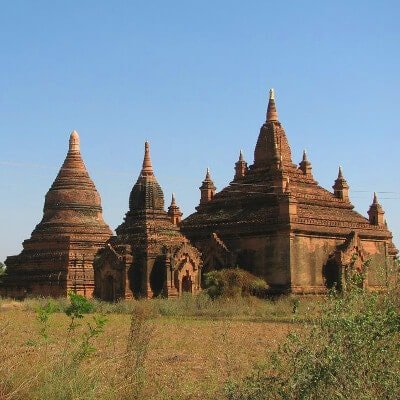
Gawdawpalin Temple
This temple, one of the four remaining temples in Old Bagan, is located on the banks of the Irrawaddy River and is the second tallest building in the area. It comprises two individual storeys with the lower one consisting of three terraces and the upper of four terraces with a hollow devotional hall. The temple was completed during the reign of King Htilominlo in 1227 AD and has undergone major repair following the 1975 earthquake.

Bupaya Stupa
It is believe that the original Bupaya Stupa was built in the 2nd or 3rd Century AD and it stood until the 1975 earthquake when it fell into the river and was destroyed. The present structure is a totally modern copy of the original’s shape albeit the new one has been gilded and it is still worth visiting especially because of the proximity to the Irrawaddy River and its location in Old Bagan on the bend in the river where you can catch any of the breeze.
